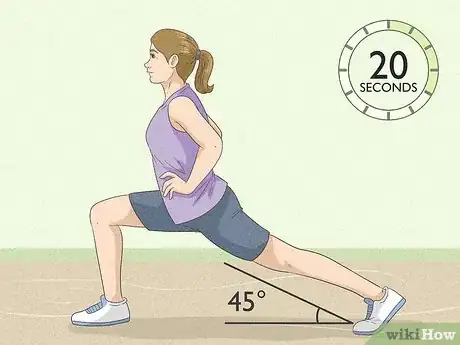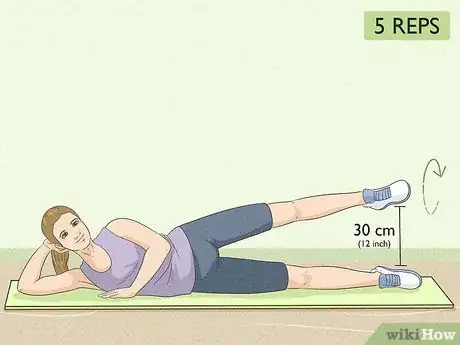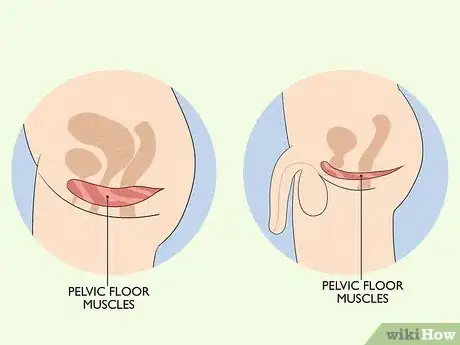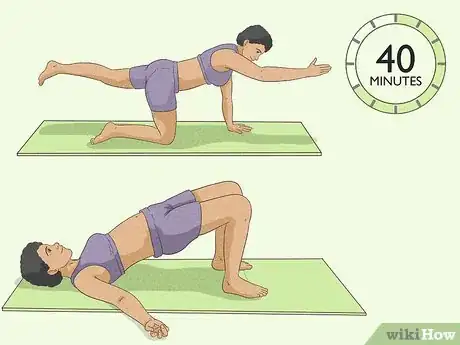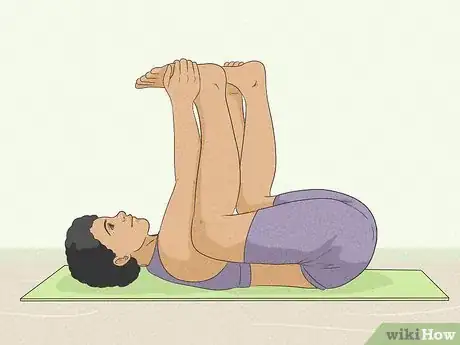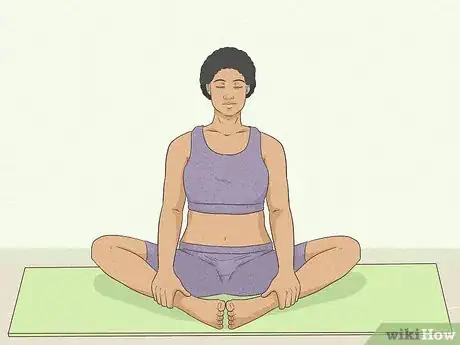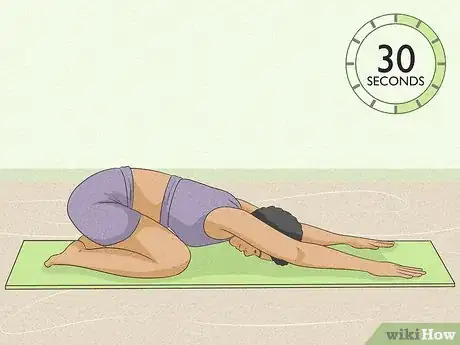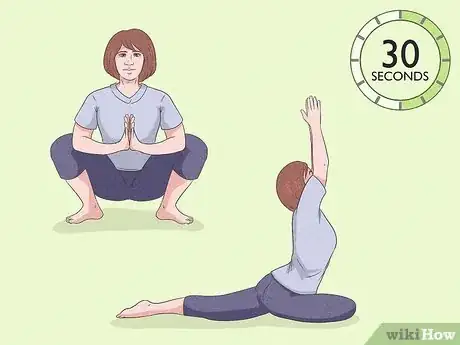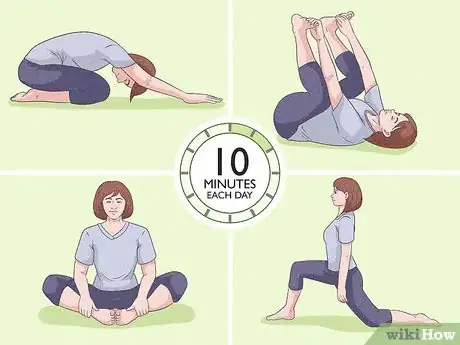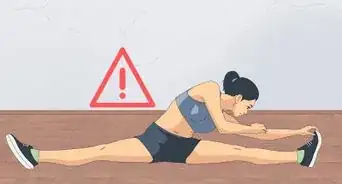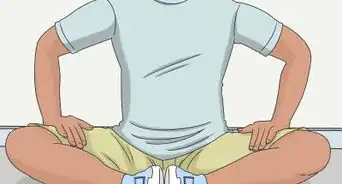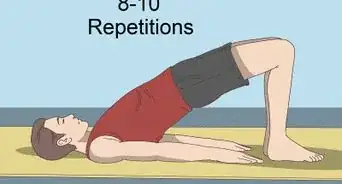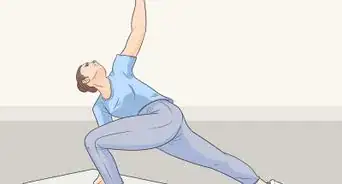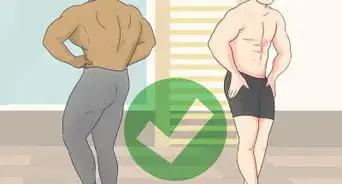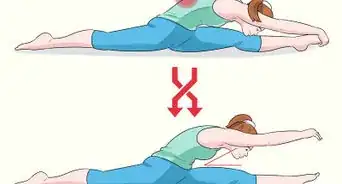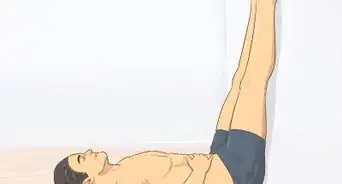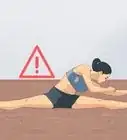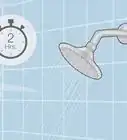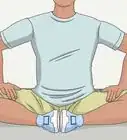This article was co-authored by Steve Horney PT, MPT, MTC, CSCS and by wikiHow staff writer, Janice Tieperman. Steve Horney is a Licensed Physical Therapist and the Owner of Integrated Health Sciences, a New York City-based company that provides continuing education, health care products, and manual and movement physical therapy. Steve has over 15 years of academic and professional physical therapy training and specializes in the assessment and treatment of athletes with the goal of helping them become pain-free and less susceptible to injury. Steve is also a certified strength and conditioning specialist (CSCS) from the National Strength and Conditioning Association (NSCA). He received a BS in Health Science from Quinnipiac University in 2004 and a Masters of Physical Therapy (MPT) from Quinnipiac University in 2006. He then completed his Manual Therapy Certification (MTC) from the University of St. Augustine in 2014.
There are 15 references cited in this article, which can be found at the bottom of the page.
This article has been viewed 17,546 times.
Pelvic stretches can reduce pain and improve your posture, and strengthening your pelvis helps to support your body as you walk and run. Start by stretching your hip flexor muscles, which can help your hips and lower back stay comfortable.[1] Also, focus on your pelvic floor muscles to reduce tension and relieve discomfort.[2] Feel free to mix and match these muscle groups as you figure out a stretching schedule that works well for you!
Steps
Hip Stretches
-
1Sit with your legs apart and lean forward. Find a flat, open area where you can sit down with your legs extended. Create a “V” shape with your legs, as though you’re forming a triangle with your hips. Hinge your hips and slowly lean forward, stretching your hips as you get closer and closer to your toes. If you’re just starting out, try to hold this position for at least 5 seconds before relaxing.[3]
- If you perform this stretch regularly, try increasing the amount of time you can hold it.
-
2Hold a hip flexor warrior pose. Stand with your feet further apart than the width of your hips. Keep 1 foot in front of the other, keeping your front knee bent while straightening your opposite leg. Keep your back foot angled at 45 degrees and pull in your abdomen, while keeping your hands balanced on your hips. Balance your weight on your front leg for at least 20 seconds, and repeat the pose by switching leg positions.[4]
- You can do this pose just about anywhere, as long as there’s enough room to take a big step forward.
- Always keep your feet more than hip-width apart.
Advertisement -
3Touch 1 foot while rotating your torso. Sit on a chair and prop 1 leg on a slightly lifted surface, like a footstool. Pretend that you’re doing a hamstring stretch by touching your toes with the opposite arm. As you hold this position, twist your torso in the direction of the leg that you’re currently stretching. While holding onto your toes with 1 arm, extend your other arm upwards at a 45-degree angle to complete the stretch. Hold this position for 20 seconds before switching to your opposite side.[5]
- For instance, you can do this stretch while sitting at a desk.
-
4Move your leg in a circular motion. Lay on your side on a flat, comfortable surface. Lift your top leg at least 12 in (30 cm) above your lower leg. Point your toes out and move your leg in a large, clockwise circle 5 times. Once you’ve done this, move your leg in counterclockwise circles for 5 reps. Then, flip over and do the same exercises with the opposite leg.[6]
- These exercises are more comfortable on a yoga mat.
- You can make this exercise more engaging by creating smaller leg circles.
- For an extra challenge, attach a light, 1.5 to 2.5 lb (0.68 to 1.13 kg) weight to the leg that you’re lifting.
-
5Experiment with a pigeon-style stretch. Sit in a comfortable seat where you can stretch your legs comfortably. Lift up 1 leg and turn your knee at a right angle, balancing your ankle on your opposite thigh. Hold your foot in place for at least 20 seconds before repeating the stretch with your opposite ankle.[7]
- This is a pretty dynamic stretch—don’t be discouraged if you aren’t able to pull it off at first!
- You may need to lean forward to really feel your muscles stretch.
-
6Practice a basic hip flexor stretch with a towel. Fold a towel and place it on a flat, open area where you can stretch. Get into a basic lunge position, with your right knee cushioned on the towel and your right leg extended behind you. Step forward with your left leg, keeping your knee bent at a 90-degree angle. Stand up straight and lean forward a bit, pushing your weight onto your left leg. Hold this stretch for up to 30 seconds, then switch your legs and perform the stretch again.[8]
- It may help to keep a hand on your waist so you aren’t tempted to bend forward.
- Try to keep your back as straight as possible during this exercise. If you curve your back, it might not be as effective.
Pelvic Floor Stretches
-
1Locate your pelvic floor muscles. These muscles are found around your genitalia and connect with your tailbone, which makes them a bit difficult to pinpoint. Imagine that you’re trying to stop yourself from urinating or passing wind. As you pause these functions, you end up tightening your pelvic floor muscles. Try to hold these muscles in place for a second or 2, just to make sure you know where they are.[9]
-
2Relax your pelvic floor muscles twice each day. If you have a lot of tension in your lower region, you may need to give your pelvic floor muscles a little extra TLC. Focus specifically on relaxing these muscles—whether you realize it or not, you may be tightening them, which can cause tension. Spend at least 40 minutes each day making an effort to relax these muscles, so you can get in the habit of keeping them relaxed.[10]
- You can multitask when you relax your pelvic floor muscles. For instance, you can practice relaxing your muscles while you work, or while you’re taking a shower.
-
3Stretch your pelvic floor muscles with the Happy Baby Pose. Find a flat, comfortable area where you can lie on your back. Keep your head and back squarely on the ground, and bend your thighs outward so they’re going out and over your hips slightly. Hold onto your ankles with both hands and slowly pull your legs toward your chest. Hold your legs in place for a minute while taking deep, slow breaths.[11]
- Use this stretch as a way to relax your pelvic floor muscles and “lower” them while you stretch.
- This is a great stretch if you’re suffering from any pain in your pelvic floor muscles.
- For this stretch to work well, you’ll need to keep your legs separated.
-
4Extend your hips with a butterfly stretch. Lie face-up on a flat surface with both knees bent and pointing upwards. Gradually lower your knees so they’re pointing outwards, as though your legs, knees, and hips are forming butterfly wings. Keep both of your feet together and continue breathing deeply while you maintain this position.[12]
- While this doesn’t directly work with your pelvic floor muscles like the Happy Baby Pose does, it helps stretch the muscles that are very close to your pelvic floor muscles.
- You’re welcome to hold this pose for more than 1 minute.
- It can be difficult to stretch your legs all the way at first—if your legs feel strained, cushion them with a pillow.
- You can sit up and multitask while performing this stretch! What matters most is that your hips, knees, and legs are bent and engaged.
-
5Lie face-down to perform the Child’s Pose. Find a comfortable place where you can sit on your knees, which gives you a good base for the rest of the pose. Point each knee outwards at a 45-degree angle or so, while your big toes are still touching. Lean forward with your torso, stretching your arms forward in straight lines. Continue leaning forward until your arms and face are touching the ground.[13]
- You can hold this pose for 30 seconds, or you can maintain this position for up to 3 minutes.[14]
- Return to your original position by extending your torso and lifting up from your tailbone.
Practicing Safe Stretching Habits
-
1Walk or move around for 10 minutes before stretching. Stretching is a great way to boost your flexibility and balance, but you don’t want to risk pulling a muscle by mistake. Instead, go for a quick walk or jog to help your muscles warm up a bit, so you don't stretch them cold.[15]
-
2Hold your stretches for up to 30 seconds. Follow your own discretion as you start stretching your pelvis. While many stretches come with time and rep recommendations, you ultimately need to listen to your body and follow your own capabilities. As you stretch more and more, you’ll be able to increase your total stretching time. Generally, 30 seconds is more than enough time to stretch out.
- Certain stretches are more free-form and don’t need to be held for regimented amounts of time, like the Happy Baby Pose or butterfly stretch.[16]
-
3Get in the habit of stretching for 10 minutes each day. Believe it or not, stretching is a great way to keep your body in tip-top shape. Set aside 10 minutes or so each day to do it, especially if you’re about to go exercising. Stretching is also a great option if you’re dealing with tense or sore muscles.
Expert Q&A
-
QuestionWhat should I know before I stretch?
 Steve Horney PT, MPT, MTC, CSCSSteve Horney is a Licensed Physical Therapist and the Owner of Integrated Health Sciences, a New York City-based company that provides continuing education, health care products, and manual and movement physical therapy. Steve has over 15 years of academic and professional physical therapy training and specializes in the assessment and treatment of athletes with the goal of helping them become pain-free and less susceptible to injury. Steve is also a certified strength and conditioning specialist (CSCS) from the National Strength and Conditioning Association (NSCA). He received a BS in Health Science from Quinnipiac University in 2004 and a Masters of Physical Therapy (MPT) from Quinnipiac University in 2006. He then completed his Manual Therapy Certification (MTC) from the University of St. Augustine in 2014.
Steve Horney PT, MPT, MTC, CSCSSteve Horney is a Licensed Physical Therapist and the Owner of Integrated Health Sciences, a New York City-based company that provides continuing education, health care products, and manual and movement physical therapy. Steve has over 15 years of academic and professional physical therapy training and specializes in the assessment and treatment of athletes with the goal of helping them become pain-free and less susceptible to injury. Steve is also a certified strength and conditioning specialist (CSCS) from the National Strength and Conditioning Association (NSCA). He received a BS in Health Science from Quinnipiac University in 2004 and a Masters of Physical Therapy (MPT) from Quinnipiac University in 2006. He then completed his Manual Therapy Certification (MTC) from the University of St. Augustine in 2014.
Licensed Physical Therapist It's important to assess your muscles to make sure that a stretch is safe to perform. If it is, make sure you warm up with a quick exercise before you stretch—you never want to stretch cold muscles.
It's important to assess your muscles to make sure that a stretch is safe to perform. If it is, make sure you warm up with a quick exercise before you stretch—you never want to stretch cold muscles.
Warnings
- Stretching should never hurt—at worst, you should only be feeling a small bit of discomfort. If you feel any kind of pain, reduce the intensity of your stretch.⧼thumbs_response⧽
- If you’re recovering from an injury, talk to your doctor before starting a stretching regimen.⧼thumbs_response⧽
References
- ↑ https://patient.info/news-and-features/the-health-benefits-of-stretching-every-day
- ↑ http://www.pelvicfloorfirst.org.au/pages/working-your-pelvic-floor.html
- ↑ https://www.spine-health.com/wellness/exercise/stretches-sacroiliac-joint-pain-relief
- ↑ https://www.nbcnews.com/better/lifestyle/sit-all-day-try-these-desk-stretches-loosen-your-hips-ncna1006566
- ↑ https://www.nbcnews.com/better/lifestyle/sit-all-day-try-these-desk-stretches-loosen-your-hips-ncna1006566
- ↑ https://uhs.princeton.edu/sites/uhs/files/documents/Pelvic-Stabilization-Hip-Strengthening.pdf
- ↑ https://www.nbcnews.com/better/lifestyle/sit-all-day-try-these-desk-stretches-loosen-your-hips-ncna1006566
- ↑ https://www.mayoclinic.org/healthy-lifestyle/fitness/multimedia/stretching/sls-20076840?s=5
- ↑ https://www.health.qld.gov.au/news-events/news/find-exercise-pelvic-floor-women-men
- ↑ https://www.bidmc.org/-/media/files/beth-israel-org/centers-and-departments/rehabilitation-services/relax_your_muscles_sheet_2016_05_rev.pdf
- ↑ https://www.ichelp.org/wp-content/uploads/2017/08/Self-Care-Stretches.pdf
- ↑ https://www.ichelp.org/wp-content/uploads/2017/08/Self-Care-Stretches.pdf
- ↑ https://www.nafc.org/bhealth-blog/how-to-relax-your-pelvic-floor
- ↑ https://www.yogajournal.com/poses/child-s-pose
- ↑ Steve Horney PT, MPT, MTC, CSCS. Licensed Physical Therapist. Expert Interview. 27 March 2020.
- ↑ https://www.ichelp.org/wp-content/uploads/2017/08/Self-Care-Stretches.pdf
- ↑ https://uhs.princeton.edu/sites/uhs/files/documents/Pelvic-Stabilization-Hip-Strengthening.pdf
- ↑ https://www.niddk.nih.gov/health-information/urologic-diseases/interstitial-cystitis-painful-bladder-syndrome/treatment
- ↑ https://www.nbcnews.com/better/lifestyle/sit-all-day-try-these-desk-stretches-loosen-your-hips-ncna1006566
- ↑ https://www.nhs.uk/common-health-questions/womens-health/what-are-pelvic-floor-exercises/

